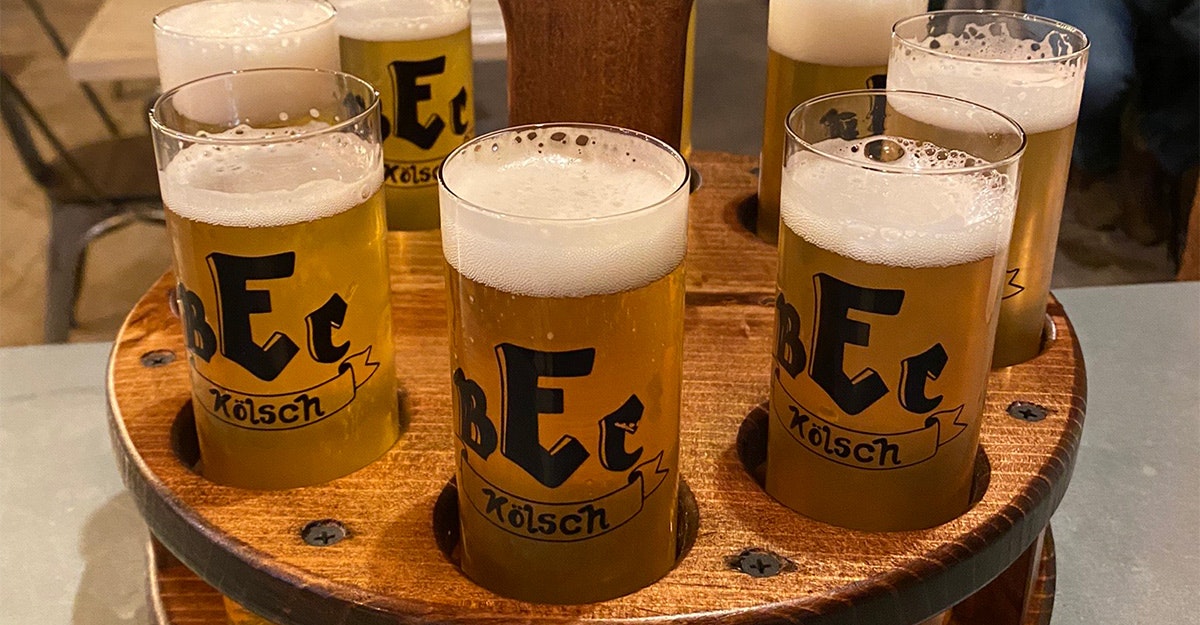I truly believe that the future of craft beer is experience-based. Creating memorable, fun, and educational events is going to be key for breweries as we move into the next stage of our industry—one in which just being a brewery isn’t enough.
When the idea of embracing classic Kölsch service at the brewery came to me, it was immediately obvious that it was perfect for the times. It would cover all the bases mentioned above—memorable, fun, educational—and would be a great way to bring people to our brewery during a tough time in the industry.
This was during the darkest depths of the pandemic. At the same time, I was working on fine-tuning our Kölsch recipe. I’d always liked it, but it was a few tweaks away from love. Amid the sea of hazy IPA and other more “exciting” modern styles, Kölsch can seem too simple to attract interest and sales. So, I needed an excuse to brew (and sell) more Kölsch!
Maybe it was the demands of those times that led the Kölsch Night idea to pop up in a few places. Once I started looking into it, I learned that Dovetail in Chicago—about two hours’ drive north of us—had already successfully hosted a couple of them. But they’re in a major population center, and I wasn’t sure whether we could pull it off in our rural area. The Kölsch service tradition is obscure, mostly known only to us true beer nerds and those who’ve found themselves in Köln.
For context, our brewery is in a century-old dairy barn in central Illinois, miles from the nearest town—and that town has 133 citizens. The next two nearest towns have a total of about 5,000 people—not exactly “populous.” Yet what we offer is a destination, a getaway from the craziness of modern life. With its low wooden ceilings, rough concrete floors, and lack of televisions, our place has a coziness that just works. When it’s filled with customers enjoying beers and conversation, it buzzes. I realized that the reasons our brewery has found success out in the sticks ought to match up pretty well with the appeal of Kölsch service.
Kölsch as a beer can be great in and of itself, but once you add in all the experiential details, it becomes something more. To do it right, you can’t cut corners. You must go the distance or the experience falls short.
Here’s how we do it.
First, there’s the stange glasses, just 200 ml each, held in the kränze (the wreath-like trays) carried by the köbes (servers). Your coaster (or deckel) acts as the tab for the evening, and you collect a tick mark for each finished beer. The next full stange should appear just as the previous one is finished—no interruptions. Then there’s the atmosphere—this is no time for loud music or cheesy Oktoberfest playlists. Think soft and relaxing, set at that perfect volume so it can just be heard. Even the beer eventually takes a back seat to conversation.
Next up is the beer menu: just Kölsch-style ale. The only other options are nonalcoholic or gluten-free. There’s something wonderfully freeing about not having a choice—about everyone in the place enjoying the same drink. It removes the distraction of scanning menus as one chooses their next beer, and it allows the conversation to flow uninterrupted.
We approach food the same way on these nights. We work with a local restaurant that caters, collect pre-orders when we receive table reservations, and everyone eats the same meal. Once dinner is served, everyone is eating the same meal and washing it down with the same beverage, all at the same time. It’s a truly wonderful and unique shared experience that’s so distinctive from ever-growing draft lists and ever-lengthening food menus.
I thought this would be an event in which we’d have to build interest through marketing and word of mouth over time. But to my delighted surprise, it’s been sold out each time we’ve done it, including the inaugural event. Now, we try to hold a Kölsch Night about three or four times a year, to keep it exciting without letting it go too long between.
And the best part is, I get to keep brewing Kölsch.


